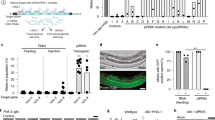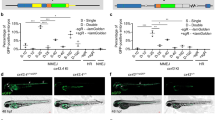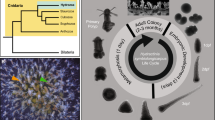Abstract
Functional genomic studies in zebrafish frequently use synthetic oligonucleotides called morpholinos that block RNA splicing or translation. However, the constitutive activity of these reagents limits their experimental utility. We report here the synthesis of a photoactivatable morpholino targeting the no tail (ntl) gene. This caged reagent permits spatiotemporal gene regulation in vivo and the photochemical generation of functionally mosaic organisms.
This is a preview of subscription content, access via your institution
Access options
Subscribe to this journal
Receive 12 print issues and online access
$259.00 per year
only $21.58 per issue
Buy this article
- Purchase on Springer Link
- Instant access to full article PDF
Prices may be subject to local taxes which are calculated during checkout


Similar content being viewed by others
References
Nasevicius, A. & Ekker, S.C. Nat. Genet. 26, 216–220 (2000).
Ordoukhanian, P. & Taylor, J.S. J. Am. Chem. Soc. 117, 9570–9571 (1995).
Tang, X. & Dmochowski, I.J. Angew. Chem. Int. Edn Engl. 45, 3523–3526 (2006).
Halpern, M.E., Ho, R.K., Walker, C. & Kimmel, C.B. Cell 75, 99–111 (1993).
Schulte-Merker, S., Ho, R.K., Herrmann, B.G. & Nusslein-Volhard, C. Development 116, 1021–1032 (1992).
Rostovtsev, V.V., Green, L.G., Fokin, V.V. & Sharpless, K.B. Angew. Chem. Int. Edn Engl. 41, 2596–2599 (2002).
Melby, A.E., Warga, R.M. & Kimmel, C.B. Development 122, 2225–2237 (1996).
Halpern, M.E. et al. Dev. Biol. 187, 154–170 (1997).
Amacher, S.L., Draper, B.W., Summers, B.R. & Kimmel, C.B. Development 129, 3311–3323 (2002).
Stemple, D.L. Development 132, 2503–2512 (2005).
Ando, R., Hama, H., Yamamoto-Hino, M., Mizuno, H. & Miyawaki, A. Proc. Natl. Acad. Sci. USA 99, 12651–12656 (2002).
Acknowledgements
We thank B. Sharpless (Scripps Research Institute) for tris(benzyltriazolylmethyl)-amine ligand; M. Halpern (Carnegie Institution of Washington) for a standard ntl morpholino; S. Schulte-Merker (Netherlands Institute for Developmental Biology) and J. Smith (Wellcome Trust/Cancer Research UK Gurdon Institute) for anti-Ntl antibody; and A. Miyawaki (RIKEN Brain Science Institute) for Kaede complementary DNA. We also thank M. Halpern for comments on the manuscript. This work was supported by the US National Institute of General Medical Sciences (R01 GM072600) and a Basil O'Connor Research Starter Award from the March of Dimes Foundation.
Author information
Authors and Affiliations
Corresponding author
Ethics declarations
Competing interests
The authors declare no competing financial interests.
Supplementary information
Supplementary Text and Figures
Supplementary Figures 1–4 and Supplementary Methods (PDF 7604 kb)
Rights and permissions
About this article
Cite this article
Shestopalov, I., Sinha, S. & Chen, J. Light-controlled gene silencing in zebrafish embryos. Nat Chem Biol 3, 650–651 (2007). https://doi.org/10.1038/nchembio.2007.30
Received:
Accepted:
Published:
Issue Date:
DOI: https://doi.org/10.1038/nchembio.2007.30
This article is cited by
-
Photocaged 5′ cap analogues for optical control of mRNA translation in cells
Nature Chemistry (2022)
-
NIR-light-mediated spatially selective triggering of anti-tumor immunity via upconversion nanoparticle-based immunodevices
Nature Communications (2019)
-
Photoresponsive biomaterials for targeted drug delivery and 4D cell culture
Nature Reviews Materials (2018)
-
Supramolecular aptamer nano-constructs for receptor-mediated targeting and light-triggered release of chemotherapeutics into cancer cells
Nature Communications (2018)
-
Illuminating developmental biology through photochemistry
Nature Chemical Biology (2017)



